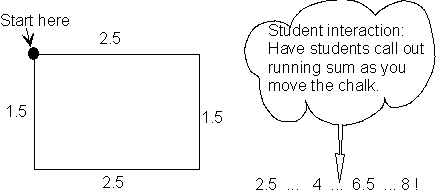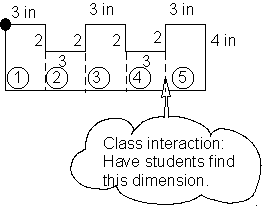Lesson Plan # 5 - More Composite Shapes - Area
Subtraction
- (5 min) Mental Math
- Start with 50, subtract 15, then divide by 5 [7]
- Add the following numbers: 6, 13, 1, and 20 [40]
- Start with 18, add 12, then divide by 3 [10]
- What is 2.5 times 2? [5]
- What is 2.5 times 20? [50]
- (5 min) Review of selected problems from Homework # 4 (<= 3
problems)
- (10 min) Discuss perimeter and area of composite shapes.
Find perimeter by the "dot" method:
Example #1:

Example #2:

Now, have the students find the area of this same figure by the following
2 methods:
Technique #1: Add up the small rectangles:
12 + 6 + 12 + 6 + 12 = 48 sq. in.
Technique #2: Use area subtraction:

Draw a line completing the outer rectangle, then compute it's area.
15 x 4 = 60 sq. in.
Then Find the area of each of the "cut-outs"
2 x 3 = 6
Then subtract the total area of the cut-outs from the outer rectangle:
60 - 6 - 6 = 48 sq. in.
BOTH METHODS GIVE YOU THE SAME ANSWER!
- (Remainder of class) In-class exercise
Note 1:
Students have a tendency to only count the labelled sides.
The "dot" method addresses this problem by getting the student
to follow around the whole figure, adding one side at a time.
Note 2:
It is important to get students to draw the line(s) separating
the rectangles from each other. It also helps to have them write
the little "number in the circle" indicating the identity of
each rectangle, so they can be sure they have added it's area to
the total.
- Hand out homework to students as they successfully complete the
in-class exercise.
|